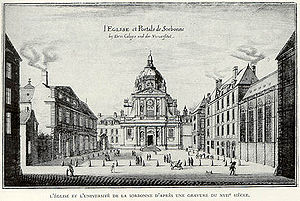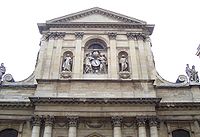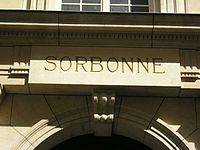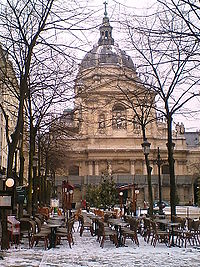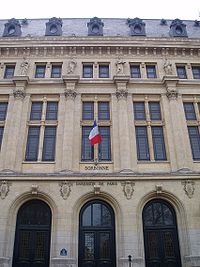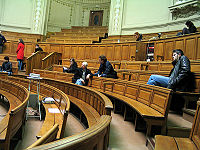- University of Paris
-
University of Paris Université de Paris 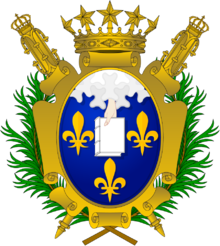
Latin: Universitas magistrorum et scholarium Parisiensis Motto Hic et ubique terrarum (Latin) Motto in English Here and anywhere on Earth Established Circa 1150-1793, 1896-1970 Type Corporative (ca. 1150-1793), public (1896-1970) Location Paris,  France
FranceCampus Urban The University of Paris (French: Université de Paris) was a university located in Paris, France and one of the earliest to be established in Europe. It was founded in the mid 12th century, and officially recognized as a university probably between 1160 and 1250 (or possibly as early as 1190).[1] After many changes, including a century of suspension (1793–1896), it ceased to exist in 1970 and 13 autonomous universities (University of Paris I–XIII) were created from it. The university is often referred to as the Sorbonne or La Sorbonne after the collegiate institution (Collège de Sorbonne) founded about 1257 by Robert de Sorbon. In fact, the university as such was older and was never completely centered on the Sorbonne. Of the 13 current successor universities, the first 4 have a presence in the historical Sorbonne building, and three include "Sorbonne" in their names.
The universities in Paris are now essentially independent of each other, and some fall under the Académie of Créteil or the Académie of Versailles rather than the Académie of Paris. Some residual administrative functions of the 13 universities are formally supervised by a common chancellor, the Rector of the Académie of Paris, with offices in the Sorbonne. As of 2006, Maurice Quénet is the Rector of the Academy of Paris and Chancellor of the Universities of Paris. The Vice-Chancellor of the Universities of Paris is Pierre Gregory.[2][3] Despite this link, and the historical ties, there is no University of Paris system that binds the universities at an academic level.
Contents
Origin and early organization
Like the other early medieval universities (Bologna, Oxford, Salamanca, Cambridge, Padua), the University of Paris was already well established before it received a specific foundation act from the Church in 1200.[4] The earliest historical reference to the university as such is found in Matthew of Paris's reference to his own teacher's study (an abbot of St. Albans) and his acceptance into "the fellowship of the elect Masters" at the university of Paris in about 1170.[5] Additionally, it is known that Pope Innocent III, having assumed the papacy at the age of 37, had completed his studies at the University of Paris by 1182 at the age of 21. It grew up in the latter part of the twelfth century around the Notre Dame Cathedral as a corporation similar to other medieval corporations, such as guilds of merchants or artisans. The medieval Latin term universitas had the more general meaning of a guild. The university of Paris was known as a universitas magistrorum et scholarium (a guild of masters and scholars). Later universities such as the Charles University in Prague or the University of Heidelberg had different origins.
The university had four faculties: Arts, Medicine, Law, and Theology. The Faculty of Arts was the lowest in rank, but also the largest as students had to graduate there to be admitted to one of the higher faculties. The students were divided into four nationes according to language or regional origin: France, Normandy, Picardy, and England. The last came to be known as the Alemannian (German) nation. Recruitment to each nation was wider than the names might imply: the English-German nation included students from Scandinavia and Eastern Europe.
The faculty and nation system of the University of Paris (along with that of the University of Bologna) became the model for all later medieval universities. Under the governance of the Church, students wore robes and shaved the tops of their heads in tonsure, to signify they were under the protection of the church. Students operated according to the rules and laws of the Church and were not subject to the king's laws or courts. This presented ongoing problems of students abusing the laws of the city, which had no direct recourse for justice and had to appeal to Church courts. Students were often very young, entering the school at age 13 or 14 and staying for 6 to 12 years.
The original schools
Three schools were especially famous at Paris, the palatine or palace school, the school of Notre-Dame, and that of Sainte-Geneviève Abbey. The decline of royalty brought about the decline of the first. The other two were ancient but did not have much visibility in the early centuries. The glory of the palatine school doubtless eclipsed theirs, until it completely gave way to them. These two centres were much frequented and many of their masters were esteemed for their learning.
The first renowned professor at the school of Ste-Geneviève was Hubold, who lived in the tenth century. Not content with the courses at Liège, he continued his studies at Paris, entered or allied himself with the chapter of Ste-Geneviève, and attracted many pupils via his teaching. Distinguished professors from the school of Notre-Dame in the eleventh century include Lambert, disciple of Filbert of Chartres; Drogo of Paris; Manegold of Germany; Anselm of Laon. These two schools attracted scholars from every country and produced many illustrious men, among whom were: St. Stanislaus of Szczepanów, Bishop of Kraków; Gebbard, Archbishop of Salzburg; St. Stephen, third Abbot of Cîteaux; Robert d'Arbrissel, founder of the Abbey of Fontevrault etc. Three other men who added prestige to the schools of Notre-Dame and Ste-Geneviève were William of Champeaux, Abélard, and Peter Lombard.
Humanistic instruction comprised grammar, rhetoric, dialectics, arithmetic, geometry, music, and astronomy (trivium and quadrivium). To the higher instruction belonged dogmatic and moral theology, whose source was the Scriptures and the Patristic Fathers. It was completed by the study of Canon law.
The school of St-Victor arose to rival those of Notre-Dame and Ste-Geneviève. It was founded by William of Champeaux when he withdrew to the Abbey of St-Victor. Its most famous professors are Hugh of St. Victor and Richard of St. Victor.
The plan of studies expanded in the schools of Paris, as it did elsewhere. A Bolognese compendium of canon law called the Decretum Gratiani brought about a division of the theology department. Hitherto the discipline of the Church had not been separate from so-called theology; they were studied together under the same professor. But this vast collection necessitated a special course, which was undertaken first at Bologna, where Roman law was taught. In France, first Orléans and then Paris erected chairs of canon law. Before the end of the twelfth century, the Decretals of Gerard (or Girard) La Pucelle, Mathieu d'Angers, and Anselm (or Anselle) of Paris, were added to the Decretum Gratiani. However, civil law was not included at Paris.
In the twelfth century, medicine began to be publicly taught at Paris: the first professor of medicine in Paris records is Hugo, physicus excellens qui quadrivium docuit.
Two things were necessary to be a professor: knowledge and appointment. Knowledge was proved by examination, the appointment came from the examiner himself, who was the head of the school, and was known as scholasticus, capiscol, and chancellor. This was called the licence or faculty to teach. The licence had to be granted freely. No one could teach without it; on the other hand, the examiner could not refuse to award it when the applicant deserved it.
The School of St-Victor, which shared the obligations as well as the immunities of the abbey, conferred the licence in its own right; the school of Notre-Dame depended on the diocese, that of Ste-Geneviève on the abbey or chapter. The diocese and the abbey or chapter, through their chancellor, gave professorial investiture in their respective territories where they had jurisdiction.
Besides Notre-Dame, Ste-Geneviève, and St-Victor, there were several schools on the "Island" and on the "Mount". "Whoever", says Crevier "had the right to teach might open a school where he pleased, provided it was not in the vicinity of a principal school." Thus a certain Adam, who was of English origin, kept his "near the Petit Pont"; another Adam, Parisian by birth, "taught at the Grand Pont which is called the Pont-au-Change" (Hist. de l'Univers. de Paris, I, 272).
The number of students in the school of the capital grew constantly, so that lodgings were insufficient. French students included princes of the blood, sons of the nobility, and the most distinguished youths of the kingdom. The courses at Paris were considered so necessary as a completion of studies that many foreigners flocked to them. Popes Celestine II, Adrian IV and Innocent III studied at Paris, and Alexander III sent his nephews there.
Illustrious German and British students included Otto of Freisingen, Cardinal Conrad, Archbishop of Mainz, St. Thomas of Canterbury, and John of Salisbury; while Ste-Geneviève became practically the seminary for Denmark. The chroniclers of the time called Paris the city of letters par excellence, placing it above Athens, Alexandria, Rome, and other cities: "At that time", we read in the Chroniques de St-Denis, "there flourished at Paris philosophy and all branches of learning, and there the seven arts were studied and held in such esteem as they never were at Athens, Egypt, Rome, or elsewhere in the world" ("Les gestes de Philippe-Auguste"). Poets said the same thing in their verses, and they compared it to all that was greatest, noblest, and most valuable in the world.
Soon, the university required greater organization to maintain order among the students and define the relations of the professors. First, the professors formed an association, for according to Matthew Paris, John of Celles, twenty-first Abbot of St Albans, England, was admitted as a member of the teaching corps of Paris after he had followed the courses (Vita Joannis I, XXI, abbat. S. Alban). The masters as well as the students were divided according to national origin, for as the same historian states, Henry II, King of England, in his difficulties with St. Thomas of Canterbury, wished to submit his cause to a tribunal composed of professors of Paris, chosen from various provinces (Hist. major, Henry II, to end of 1169). This was probably the beginnings of that division according to "nations" which was later to play an important part in the university. After a decision made by Celestine III, both professors and students had the privilege of being amenable only to the ecclesiastical courts, not to civil courts. Other decisions dispensed them from residence in case they possessed benefices and permitted them to receive their revenues.
The three schools of Notre-Dame, Ste-Geneviève, and St-Victor may be regarded as the triple cradle of the Universitas scholarium, which included masters and students; hence the name University. Henry Denifle and some others hold that this honour is exclusive to the school of Notre-Dame (Chartularium Universitatis Parisiensis), but the reasons do not seem convincing. He excludes St-Victor because, at the request of the abbot and the religious of St-Victor, Gregory IX in 1237 authorized them to resume the interrupted teaching of theology. But the university was in large part founded about 1208, as is shown by a Bull of Innocent III. Consequently the schools of St-Victor might well have furnished their contingent towards its formation. Secondly, Denifle excludes the schools of Ste-Geneviève because there had been no interruption in the teaching of the liberal arts. Now this is far from proved, and moreover, it seems incontestable that theology also had never ceased to be taught, which is sufficient for our point. Besides, the chancellor of Ste-Geneviève continued to give degrees in arts, something he would have ceased to have done when the university was organized if his abbey had no share in its organization. And while the name Universitas scholarium is quite intelligible on the basis of the common opinion, it is incompatible with the recent (Denifle's) view, according to which there would have been schools outside the university of paris.
Organization in the thirteenth century
In 1200, King Philip II issued a diploma "for the security of the scholars of Paris" that made the students subject only to ecclesiastical jurisdiction. The provost and other officers were forbidden to arrest a student for any offence, unless this was done to hand over the culprit to ecclesiastical authority. The king's officers could never lay hands on the head of the schools unless they had a mandate from an ecclesiastical authority. This action was motivated at least in part by a violent incident between students and officers outside the city walls at a pub.
In 1215, the Apostolic legate, Robert de Courçon, issued new rules governing who could become a professor. To teach the arts it was necessary to have reached the age of twenty-one, to have studied these arts at least six years, and to take an engagement as professor for at least two years. For a chair in theology the candidate had to be thirty years of age with eight years of theological studies, of which the last three years were devoted to special courses of lectures in preparation for the mastership. These studies had to be made in the local schools under the direction of a master, for at Paris one was not regarded as a scholar unless he had a particular master. Lastly, purity of morals was as important as reading. The licence was granted, according to custom, gratuitously, without oath or condition. Masters and students were permitted to unite, even by oath, in defence of their rights, when they could not otherwise obtain justice in serious matters. No mention is made either of law or of medicine, probably because these sciences were less prominent.
Priscian's "Grammar", Aristotle's "Dialectics", mathematics, astronomy, music, rhetoric and philosophy were taught in the arts course; to these might be added the Ethics of the Stagyrite and the fourth book of the Topics. But it was forbidden to read the books of Aristotle on Metaphysics and Physics, or abbreviations of them.
Main article: University of Paris strike of 1229In 1229, a denial of justice by the queen led to suspension of the courses. The pope intervened with a Bull that began with lavish praise of the university: "Paris", said Gregory IX, "mother of the sciences, is another Cariath-Sepher, city of letters". He commissioned the Bishops of Le Mans and Senlis and the Archdeacon of Châlons to negotiate with the French Court for the restoration of the university, but by the end of 1230 they had accomplished nothing. Gregory IX then addressed a Bull of 1231 to the masters and scholars of Paris. Not only did he settle the dispute, he empowered the university to frame statutes concerning the discipline of the schools, the method of instruction, the defence of theses, the costume of the professors, and the obsequies of masters and students (expanding upon Robert de Courçon's statutes). Most importantly, the pope granted the university the right to suspend its courses, if justice were denied it, until it should receive full satisfaction.
The pope authorized Pierre Le Mangeur to collect a moderate fee for the conferring of the license of professorship. Also, for the first time, the scholars had to pay for their education: two sous weekly, to be deposited in the common fund.
The Rector
The university was organized as follows: at the head of the teaching body was a rector. The office was elective and of short duration; at first it was limited to four or six weeks. Simon de Brion, legate of the Holy See in France, realizing that such frequent changes caused serious inconvenience, decided that the rectorate should last three months, and this rule was observed for three years. Then the term was lengthened to one, two, and sometimes three years. The right of election belonged to the procurators of the four nations.
The four nations
Main article: Nation (university)The "Nations" appeared in the second half of the twelfth century; they were mentioned in the Bull of Honorius III in 1222; later they formed a distinct body. By 1249 the four nations existed with their procurators, their rights (more or less well-defined), and their keen rivalries: the nations were the French, English, Normans, and Picards. After the Hundred Years' War the English nation was replaced by the Germanic. The four nations constituted the faculty of arts or letters.
The territories covered by the four nations were:
- French nation: all the Romance-speaking parts of Europe except those included within the Norman and Picard nations
- English nation (renamed 'German nation' after the Hundred Years' War): the British Isles, the Germanic-speaking parts of continental Europe (except those included within the Picard nation), and the Slavic-speaking parts of the Europe. The majority of students within that nation came from Germany and Scotland, and when it was renamed 'German nation' it was also sometimes called natio Germanorum et Scotorum ("nation of the Germans and Scots").[6][7]
- Norman nation: ecclesiastical province of Rouen, which corresponded approximately to the Duchy of Normandy. This was a Romance-speaking territory, but it was not included within the French nation.
- Picard nation: the Romance-speaking bishoprics of Beauvais, Noyon, Amiens, Laon, and Arras; the bilingual (Romance and Germanic-speaking) bishoprics of Thérouanne, Cambrai, and Tournai; a large part of the bilingual bishopric of Liège; the southernmost part of the Germanic-speaking bishopric of Utrecht (the part of that bishopric located south of the Meuse River; the rest of the bishopric north of the Meuse River belonged to the English nation). It was estimated that about half of the students in the Picard nation were Romance-speakers (Picard and Walloon), and the other half were Germanic-speakers (West Flemish, East Flemish, Brabantian and Limburgish dialects).[8]
Faculties
To classify professors' knowledge, the schools of Paris gradually divided into faculties. Professors of the same science were brought into closer contact until the community of rights and interests cemented the union and made them distinct groups. The faculty of medicine seems to have been the last to form. But the four faculties were already formally established by 1254, when the university described in a letter "theology, jurisprudence, medicine, and rational, natural, and moral philosophy". The masters of theology often set the example for the other faculties, e.g. they were the first to adopt an official seal.
The faculties of theology, canon law, and medicine, were called "superior faculties". The title of "Dean" as designating the head of a faculty, came into use by 1268 in the faculties of law and medicine, and by 1296 in the faculty of theology. It seems that at first the deans were the oldest masters. The faculty of arts continued to have four procurators of its four nations and its head was the rector. As the faculties became more fully organized, the division into four nations partially disappeared for theology, law and medicine, though it continued in arts. Eventually the superior faculties included only doctors, leaving the bachelors to the faculty of arts. At this period, therefore, the university had two principal degrees, the baccalaureate and the doctorate. It was not until much later that the licentiate and the DEA became intermediate degrees.
Colleges
The scattered condition of the scholars in Paris often made lodging difficult. Some students rented rooms from townspeople, who often exacted high rates while the students demanded lower. This tension between scholars and citizens would have developed into a sort of civil war if Robert de Courçon had not found the remedy of taxation. It was upheld in the Bull of Gregory IX of 1231, but with an important modification: its exercise was to be shared with the citizens. The aim was to offer the students a shelter where they would fear neither annoyance from the owners nor the dangers of the world. Thus were founded the colleges (colligere, to assemble); meaning not centers of instruction, but simple student boarding-houses. Each had a special goal, being established for students of the same nationality or the same science. Often, masters lived in each college and oversaw its activities.
Four colleges appeared in the twelfth century; they became more numerous in the thirteenth, including Collège d'Harcourt (1280) and the Collège de Sorbonne (1257). Thus the University of Paris assumed its basic form. It was composed of seven groups, the four nations of the faculty of arts, and the three superior faculties of theology, law, and medicine. Men who had studied at Paris became an increasing presence in the high ranks of the Church hierarchy; eventually, students at the University of Paris saw it as a right that they would be eligible to benifices. Church officials such as St. Louis and Clement IV lavishly praised the university.
Besides the famous Collège de Sorbonne, other collegia provided housing and meals to students, sometimes for those of the same geographical origin in a more restricted sense than that represented by the nations. There were 8 or 9 collegia for foreign students: the oldest one was the Danish college, the Collegium danicum or dacicum, founded in 1257. Swedish students could, during the 13 and 14th centuries, live in one of three Swedish colleges, the Collegium Upsaliense, the Collegium Scarense or the Collegium Lincopense, named after the Swedish dioceses of Uppsala, Skara and Linköping. The German College, Collegium alemanicum is mentioned as early as 1345, the Scots college or Collegium scoticum was founded in 1325. The Lombard college or Collegium lombardicum was founded in the 1330s. The Collegium constantinopolitanum was, according to a tradition, founded in the 13th century to facilitate a merging of the eastern and western churches. It was later reorganized as a French institution, the Collège de la Marche-Winville. The Collège de Montaigu was founded by the Archbishop of Rouen in the 14th century, and reformed in the 15th century by the humanist Jan Standonck, when it attracted reformers from within the Roman Catholic Church (such as Erasmus and Ignatius of Loyola) and those who subsequently became Protestants (John Calvin and John Knox).
Later history
In the fifteenth century, Guillaume d'Estouteville, a cardinal and Apostolic legate, carried out a project to reform the university, correcting its abuses and introducing various needed modifications. This reform was less an innovation than a recall to the better observance of the old rules, as was the reform of 1600, undertaken by the royal government, with regard to the three superior faculties. However, as to the faculty of arts, the reform of 1600 introduced the study of Greek, of the French poets and orators, and of additional classical figures like Hesiod, Plato, Demosthenes, Cicero, Virgil, and Sallust. The prohibition to teach civil law was never well observed at Paris, but in 1679 Louis XIV authorized the teaching of civil law in the faculty of decretals. Thus, the name "faculty of law" replaced that of "faculty of decretals". The colleges meantime had multiplied; those of Cardinal Le-Moine and Navarre were founded in the fourteenth century. The Hundred Years' War was fatal to these establishments, but the university set about remedying the injury.
Remarkable for its teaching, the University of Paris played an important part: in the Church, during the Great Schism; in the councils, in dealing with heresies and divisions; in the State, during national crises. Under the domination of England it played a role in the trial of Joan of Arc.
Proud of its rights and privileges, the University of Paris fought energetically to maintain them, hence the long struggle against the mendicant orders on academic as well as on religious grounds. Hence also the shorter conflict against the Jesuits, who claimed by word and action a share in its teaching. It made liberal use of its right to decide administratively according to occasion and necessity. In some instances it openly endorsed the censures of the faculty of theology and pronounced condemnation in its own name, as in the case of the Flagellants.
Its patriotism was especially manifested on two occasions. During the captivity of King John, when Paris was given over to factions, the university sought to restore peace; and under Louis XIV, when the Spaniards crossed the Somme and threatened the capital, it placed two hundred men at the king's disposal and offered the Master of Arts degree gratuitously to scholars who should present certificates of service in the army (Jourdain, Hist. de l'Univers. de Paris au XVIIe et XVIIIe siècle, 132-34; Archiv. du ministère de l'instruction publique).
Suppression of the colleges and establishment of the University of France
The ancient university disappeared with ancient France in the French Revolution. On 15 Sept., 1793, petitioned by the Department of Paris and several departmental groups, the National Convention decided that independently of the primary schools,
"there should be established in the Republic three progressive degrees of instruction; the first for the knowledge indispensable to artisans and workmen of all kinds; the second for further knowledge necessary to those intending to embrace the other professions of society; and the third for those branches of instruction the study of which is not within the reach of all men".
Measures were to be taken immediately: "For means of execution the department and the municipality of Paris are authorized to consult with the Committee of Public Instruction of the National Convention, in order that these establishments shall be put in action by 1 November next, and consequently colleges now in operation and the faculties of theology, medicine, arts, and law are suppressed throughout the Republic". This was the death-sentence of the university. It was not to be restored after the Revolution had subsided, any more than those of the provinces.
All the faculties were replaced by a single centre, the University of France. After a century, people recognized that the new system was less favourable to study. They restored the old system of separate faculties in 1896, but without the faculty of theology.
Student revolt and reorganization
In 1968 the cultural revolution (see also Situationist International), resulted in the closing of the university for the third time in history. (The first occasion had been in 1229, and the second had been due to the invasion by the German army of 1940.) In 1968, students were protesting against the organization of the university and its restrictions, as well as general social issues.
The University of Paris has subsequently been reorganised into several autonomous universities and schools, some of which still carry the Sorbonne name. The historical campus, located in the Quartier Latin on the Rive Gauche, in the 5th arrondissement of Paris, features mural paintings by Pierre Puvis de Chavannes. It was divided for use among several of the universities of Paris, the prestigious École Nationale des Chartes and the Rector's services.
In March 2006 la Sorbonne was occupied again as part of country-wide protests against the government's introduction of the CPE (first employment contract), which some young people thought would adversely affect them.
Present universities
The thirteen successor universities to the University of Paris are now split over the three academies of the Île-de-France region.
Thirteen successor universities
I Pantheon-Sorbonne University Website Academy of Paris Sorbonne Paris Cité II Pantheon-Assas University Website Academy of Paris Sorbonne Universités III University of the New Sorbonne Website Academy of Paris Sorbonne Paris Cité IV Paris-Sorbonne University Website Academy of Paris Sorbonne Universités V René Descartes University Website Academy of Paris Sorbonne Paris Cité VI Pierre and Marie Curie University Website Academy of Paris Sorbonne Universités VII Denis Diderot University Website Academy of Paris Sorbonne Paris Cité VIII University of Vincennes in Saint-Denis Website Academy of Créteil not in an alliance IX Paris Dauphine University Website Academy of Paris not in an alliance X University of Paris Ouest Website Academy of Versailles not in an alliance XI University of Paris Sud Website Academy of Versailles UniverSud Paris XII University of Paris Est Website Academy of Créteil Université Paris-Est XIII University of Paris Nord Website Academy of Créteil Université Paris Cité Five alliances of universities
Most of these universities have joined, or are in the process of forming (Summer 2010), new groupings along the lines of a collegiate university. Typically, these groupings take the legal form of a Center for Research and Higher Education (Pôle de Recherche et d'Enseignement Supérieur, or PRES), though some have opted for other forms of organization. These groupings mix universities and grandes écoles.
There are five such centers in the Paris region:
Some alliances have been terminated, such as Paris Universitas or Paris Centre Universités, some other are still in discussion.
See also
- University of Paris strike of 1229
- University of Paris (Condemnations)
- List of University of Paris people
- List of public universities in France by academy
- Sorbonne Graduate Business School
- École normale supérieure
- Nobel Prize Ranking
- List of medieval universities
- Société des Amis des Universités de Paris
References
- ^ Haskins, C. H.: The Rise of Universities, page 292. Henry Holt and Company, 1923.
- ^ [1][dead link]
- ^ [2][dead link]
- ^ Rubenstein, Richard E.: Aristotle's Children, page 161. Harvest Books, 2004.
- ^ §1. The University of Paris. X. English Scholars of Paris and Franciscans of Oxford. Vol. 1. From the Beginnings to the Cycles of Romance. The Cambridge History of English and...
- ^ Miscellanea Scotica.: A Collection of Tracts Relating to the History
- ^ Historical Tales of the Wars of Scotland, and of the Border Raids
- ^ « Picard » et « Picardie », espace linguistique et structures sociopolitiques, by Serge Lusignan and Diane Gervais, August 2008
- ^ PRES Sorbonne Universités - Bienvenue sur le site du PRES Sorbonne Universités
- ^ Sorbonne Paris Cité
- ^ Université Paris-Est
- ^ UniverSud Paris | Un pôle de recherche et d'enseignement supérieur dans le sud de l'Ile de France
 This article incorporates text from a publication now in the public domain: Herbermann, Charles, ed (1913). "University of Paris". Catholic Encyclopedia. Robert Appleton Company.
This article incorporates text from a publication now in the public domain: Herbermann, Charles, ed (1913). "University of Paris". Catholic Encyclopedia. Robert Appleton Company.
Further reading
- André Tuilier: Histoire de l'Université de Paris et de la Sorbonne ("History of the University of Paris and of the Sorbonne"), in 2 volumes (From the Origins to Richelieu, From Louis XIV to the Crisis of 1968), Paris: Nouvelle Librairie de France, 1997 ;
- Jean-Louis Leutrat: De l'Université aux Universités ("From the University to the Universities"), Paris: Association des Universités de Paris, 1997
- Philippe Rive: La Sorbonne et sa reconstruction ("The Sorbonne and its Reconstruction"), Lyon: La Manufacture, 1987
- Jacques Verger: Histoire des Universités en France ("History of French Universities"), Toulouse: Editions Privat, 1986
External links
- Study Abroad in France (English)
- Academy of Paris (French)
- Sorbonne - Universités Paris I, III, IV and V (official homepage)
- History of the University of Paris (French)
- News coverage of the most recent occupation of the Sorbonne
- Education Authority of Paris (French)
- english language coverage of the struggle against the CPE in France, including the occupations and demonstrations around the Sorbonne
Categories:- University of Paris
- Educational institutions established in the 12th century
- 12th-century establishments in France
Wikimedia Foundation. 2010.

